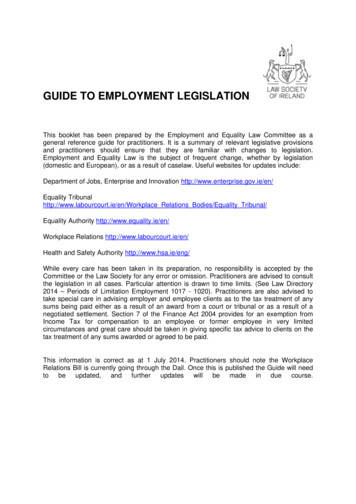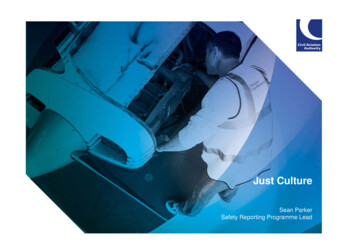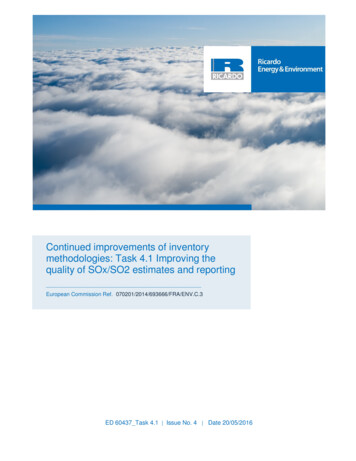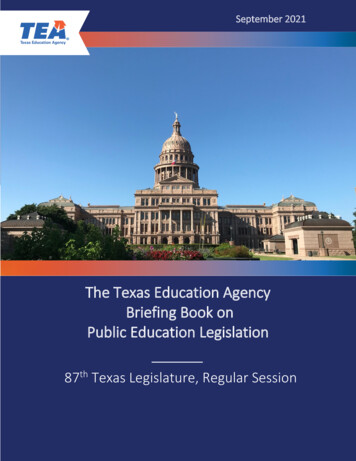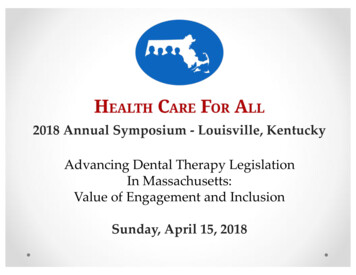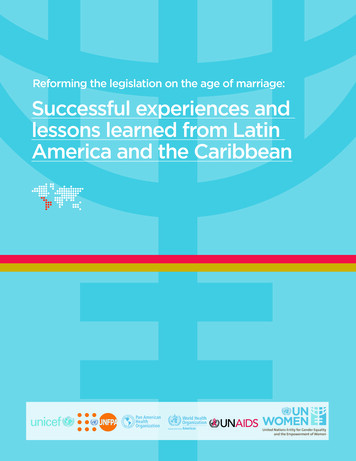
Transcription
Reforming the legislation on the age of marriage:Successful experiences andlessons learned from LatinAmerica and the Caribbean
Guidance note on successful experiences and lessons learned on change oflegislation on the age of marriage, with a special emphasis on Latin America andthe Caribbean11Commissioned by UN Women as part of the regional inter-agency flagship initiative in LAC with UNICEF, UNFPA, PAHO/WHOand UNAIDS. This flagship initiative is part of the workplan of the UN regional inter-agency group on gender equality and women’sempowerment of the UNDG LAC. Compiled by Rocío Rosero Garcés and Cecilia Valdivieso Vega.ISBN: 978-1-63214-055-5The views expressed in this publication are those of the authors and do not necessarily represent the views of UN Women, UNICEF, UNFPA, PAHO/WHO,UNAIDS, the United Nations or any of its affiliated organizations.REFORMING THE LEGISLATIONON THE AGE OF MARRIAGE2
TABLE OF CONTENTS1. INTRODUCTION2. REGIONAL CONTEXTChild marriage in numbersDetermining factors for child marriageEducationSexual initiationTeenage pregnancyViolence3. HUMAN RIGHTS STANDARDS REGARDING THE MINIMUMAGE OF MARRIAGE3.1 Principle of the Convention on the Rights of the Childand the Convention on the Elimination of All Forms ofDiscrimination Against Women3.2 Child marriage: a harmful traditional practicethat violates human rightsRight to a life free of violenceRight to health and sexual and reproductive rightsRight to education151516164. EXPERIENCES OF LEGISLATIVE REFORM ON THEMINIMUM AGE FOR MARRIAGE IN COUNTRIES INTHE REGION OF LATIN AMERICA AND THE CARIBBEAN4.1 Successful experiences in Ecuador, Mexico and Panama4.2 Lessons learned and challenges4.3 Factors of success4.4 Recommendations18192123245. GUIDELINES FOR THE INCORPORATION OFINTERNATIONAL HUMAN RIGHTS STANDARDS ON THEMINIMUM AGE OF MARRIAGE IN NATIONAL LEGISLATION5.1 Guiding principles for the legislative reform process5.2 Guidelines and standards to be considered inlegislative reformAnnex 1: List of persons interviewedAnnex 2: BibliographyAnnex 3: Summary of International Human RightsStandards Regarding The Minimum Age of MarriageBased on the Groups of Affected Rights3REFORMING THE LEGISLATIONON THE AGE OF MARRIAGE46779910101213262729313235
1INTRODUCTIONThe United Nations regional inter-agency groupfor gender equality and women’s empowermentin Latin America and the Caribbean (GIG),coordinated by UN Women, has decided toimplement an inter-agency regional flagshipinitiative for 2015-2016, with the aim of helping to“end early and child marriage in Latin America andthe Caribbean”.Photo: UN Women /Gustavo StephanREFORMING THE LEGISLATIONON THE AGE OF MARRIAGE4
This initiative is directed jointly by UNICEF, UNFPA, UNAIDS, PAHO/WHO and UN Women and seeks tocontribute to the implementation of legislative changes to eliminate all exceptions to the legal age ofmarriage in countries in the region. These five agencies are aware that legislative changes in one area aloneare not sufficient to promote the human rights of girls in the region. However, it is a practical and strategicstarting point that unites agencies’ agendas around a common goal. It is also understood to be one ofmany interventions that contributes to protecting the rights of girls and promoting their empowerment.The regional initiative is aligned with the joint UNFPA-UNICEF Global Programme to Accelerate Action toEnd Child Marriage 2016-2019 and contributes to global efforts already underway to end child marriage inthe region.Joint general recommendation/general comment No. 31of the Committee on the Elimination of Discriminationagainst Women and No. 18 of the Committee on theRights of the Child calls for states to consider thatharmful practices are deeply engrained in socialattitudes that see women and girls as inferior to menand boys based on stereotypical roles. The Committeeshighlight the gender dimension of violence and statethat sex- or gender-based attitudes and stereotypes,power imbalances, inequalities and discriminationperpetuate the widespread existence of practicesthat often involve violence or coercion. Furthermore,the Committees draw the attention of States partiesto the fact that discrimination due to sex or gender isintertwined with other factors that affect women andgirls, particularly those connected with, or appearingto be connected with, disadvantaged groups who aretherefore more likely to be the victims of harmfulpractices2.This Guidance Note has been drawn up in order toinform United Nations personnel, legislators, publicpolicy advisors and civil society organizations aboutthe international human rights standards regardingthe obligation of States to raise the minimum age ofmarriage; examples are provided from various LatinAmerican and Caribbean countries in making nationallegislation compatible with these standards andrecommendations regarding actions and approachesthat can result in such processes.25Joint general recommendation/general comment No. 31 of theCommittee on the Elimination of Discrimination against Womenand No. 18 of the Committee on the Rights of the Child onharmful practices. CEDAW/C/GC/31/CRC/C/GC/18. 014/9925.pdf?view 1REFORMING THE LEGISLATIONON THE AGE OF MARRIAGEWhat is child or early marriage?According to the Committee on the Elimination ofDiscrimination against Women and the Committee onthe Rights of the Child, “Child marriage, also referred toas early marriage, is any marriage where at least one ofthe parties is under 18 years of age. The overwhelmingmajority of child marriages, both formal and informal,involve girls, although at times their spouses are alsounder the age of 18. A child marriage is consideredas a form of forced marriage given that one or bothparties have not expressed their full, free and informedconsent”3.Child marriage, such as de facto unions or earlyconjugal unions, have a number of long-term negativeconsequences that affect the rights of girls and boys,particularly the right to education, to a life free ofviolence, to express their opinions, and to sexual andreproductive health, which have an impact on their lifeplans.3Ibid.
2REGIONAL CONTEXTWhereas globally the practice of child marriagehas slowly been decreasing since the 1980s, nosignificant changes have been seen in this region.Photo: UN Women /Claudia Quilali6REFORMING THE LEGISLATIONON THE AGE OF MARRIAGE
Child marriage in numbersDetermining factors for child marriageGlobally, in developing countries, 1 in every 3 youngwomen aged 20-24 years, i.e. 70 million women, marrybefore the age of 18; one-third marry before the age of15 years4 .Some studies on child marriage have been publishedby United Nations agencies and specialized NGOs thatrefer to structural factors regarding problems such asteenage pregnancy and child marriage, such as poverty,geographical location, regulations that discriminateagainst women and young people, and limited accessto education, including sex education. However, thereis insufficient information to compare the situation inevery country in the region.In 61 countries in all regions of the world, childmarriage occurs in 20 per cent of cases. In somecountries, especially in Latin America and West Africa,early marriages are commonplace and the underlyinggender dimensions to this phenomenon often havenegative lifelong consequences due to the seriousnessof their impacts.5According to information from UNICEF , 30 per cent ofwomen between the ages of 20 and 49 in Latin Americaand the Caribbean were married or entered into aunion before the age of 18, while 18 per cent marriedbefore the age of 15. In Mexico data from the 2014National Survey of Demographic Dynamics (ENADID)suggest that 21.5% of women aged 20-24 entered intoa union before reaching full age, and 3.8% before theage of 15. Currently 19 per cent of girls aged 15-19, orone in five, are married or in a de facto union. Childmarriage rates in Latin America and the Caribbean areslightly below the world average. However, whereasglobally the practice of child marriage has slowly beendecreasing since the 1980s, no significant changeshave been seen in this region.In countries in the region, the prevalence of childmarriage in rural areas is almost double that of urbanareas; girls from poor families and those living in ruralareas are particularly vulnerable. Whereas in thewealthiest quintile it is estimated that 10 per cent ofwomen aged between 20 and 49 married before theage of 18, the proportion is as high as 38 per cent forthe poorest quintile. Indigenous girls are particularly6affected , which contributes to the reproduction ofintergenerational poverty. However, unlike rural andurban areas of Mexico, conjugal unions do not occurespecially early in rural zones compared with cities;in other words, child marriage is not a problem that7exclusively affects girls or adolescents in rural areas .4567Resolución aprobada por la Asamblea General el 18 dediciembre de 2014 69/156. Matrimonio infantil, precoz y os/BDL/2015/9953.pdf?view 1UNICEF LACRO. Legal minimum ages and the realization ofadolescents’ rights. January, 2015. UNICEF Gender Action Plan2014-2017. E/ICEF/2014/CRP.12 April 2014.UNICEF, Regional guide on adolescents, 2014.ONU Mujeres. El matrimonio infantil en México: niveles ydiferenciales socioeconómicos por entidad federativa (Childmarriage in Mexico: socioeconomic levels and differencesbetween federal entities). 2015. p.3As remarked in the UNFPA global study on childmarriage, this phenomenon continues in poor ruralareas in developing countries, partly due to localtradition. In some cases parents believe their daughterswill be protected and in other situations conflicts pushthem in this direction. But above all child marriage isthe result of a lack of life options: girls are removedfrom the education system and remain vulnerable andmore exposed to child marriage.According to the results of the study carried outby PROMUNDO8 in Brazil in 2015, the main factorsleading to child marriage are: unwanted teenagepregnancy and the family’s interest in protecting thegirl’s reputation and ensuring the baby’s future; thedesire to control adolescents’ sexuality and avoid riskybehavior; the pursuit of economic security by the girl’sfamily; removal of girls from their parents’ householddue to the lack of educational and employmentopportunities; abusive experiences or control ofmobility. Another factor is the desire of men to marryyounger wives, who are considered more attractiveand easier to control; husbands are on average 9 yearsolder than their wives. The study also revealed thatsocial services are unsatisfactory and in many casesdiscriminatory, and also noted the lack of protectionfor married girls’ rights. This combination of factorsleads to practices that are detrimental to the rights ofgirls, boys and women.Poverty levelsAlthough poverty is not the cause of child marriage, itconsiderably impacts the life projects of women andgirls. In as much as girls and adolescents do not haveaccess to education, they have fewer opportunities tomake informed decisions regarding actions outsidethe home. As a consequence, they can be seen as aneconomic burden by their families, even unable to fendfor themselves. This concern that some families haveregarding the expenses they think their daugthers8PROMUNDO. She goes with me in my boat”: Child andAdolescent Marriage in Brazil. Executive Summary. July2015. 07/SheGoesWithMeInMyBoat ExecutiveSummary ES web.pdfREFORMING THE LEGISLATIONON THE AGE OF MARRIAGE7
represent is something that can result in the familyselling them and even allowing them to be exploitedfor work9.Some mothers and fathers genuinely believe thatmarriage will guarantee the future of their daughterswhile others see them effectively as a burden oreven a commodity. In this context child marriage isunderstood as a mechanism that allows girls andadolescents to lead a healthy and productive life. Yetchild marriage ultimately denies girls the opportunityto fully develop their potential and grow as empoweredcitizens, which limits their personal chances and has asocial and economic impact on communities10.According to a study carried out in 2015 by UN WomenMexico for that country, the figures show a correlationbetween child marriage and the socioeconomic level;households with a higher level of education or a highersocioeconomic level have significantly lower rates ofchild marriage: 2 per cent among university graduatesand 4.2 per cent in the highest socioeconomic stratum.The link between the level of education and the age ofmarriage for girls confirms that education is crucial inpreventing this type of harmful practice.The results of the UNFPA global study on child marriageshow that girls living in rural areas of developingcountries are twice as likely to marry or enter into afree union as their urban counterparts (44 per centversus 22 per cent, respectively)11. This is occurring in acontext of urbanization and minimal decentralizationin which children, adolescents and young people inrural areas have less access to quality services andfewer opportunities to continue their education.Gender stereotypesAccording to qualitative and quantitative studieson child marriage, the issue of poverty can influenceand in some countries can be decisive. However, childmarriage is rooted in the many gender disparitiesthat are expressed and reproduced through practices,9Igualdad Ya. Proteger a las niñas. El uso de la ley paraerradicar los matrimonios infantiles, prematuros y forzados yotras violaciones de derechos humanos relacionadas (EqualityAlready. Protecting girls. Using the law to eliminate child, earlyand forced marriage and other related human rights abuses).January, 201410UNFPA, Marrying Too Young. End child marriage. New York,2012. Pág. 1211The investigation “Marrying Too Young. End child marriage”carried out by UNFPA in 2012 was based exclusively on datafrom 48 countries.8REFORMING THE LEGISLATIONON THE AGE OF MARRIAGElanguage and symbolic representations that are thecause of discrimination and violence.Child marriage is undoubtedly a problem that reflectsgender inequalities. There are no disaggregated datafor all countries but it is important for information tobe made available to guide public policy actions anddefinitions. In Mexico’s case12, 3.8% of women aged20-24 were married before the age of 15 and 21.5% ofwomen in the same age group married before the ageof 1813. These figures allow us to conclude that womenwere married as minors to men who were considerablyolder than them.According to information from various studies incountries in the region, social norms regardingtraditional masculine roles14 are based on factors suchas productivity, initiative, heterosexuality, decisionmaking, autonomy, rationality, willingness to holdpower, and repression of emotions; this encouragesrisky behavior and the violent resolution of conflictsthat is confirmed by naming conventions; meanwhilenorms regarding traditional female roles reproducesociocultural patterns of subordination in all areas,perpetuating the underlying dynamic of gender powerin all social relations from infancy onwards. Based onthis logic, communication methods also play a rolesince unequal power relationships and dynamics arereproduced that make acceptable the image and roleof women in a position of inferiority and dependence.All this is played out in daily dynamics via subordinatepowerrelationships, productionrelationshipsand emotional and sexual relations that lead tosociocultural mandates and patterns with privilegedcontrol positions for men compared with dependenceand subordination for women.(.) the persistence of a chauvinistic culturedespite the significant advances girls andwomen have achieved in the region; theresulting gender inequality and the negativeattitudes of boys and men toward girls andwomen; the norms that perpetuate violence12UN Women Mexico, El matrimonio infantil en México: nivelesy diferenciales socioeconómicos por entidad federativa (Childmarriage in Mexico: socioeconomic levels and differencesbetween federal entities). Working document, 2015.13Source: UN Women based on the National Survey ofDemographic Dynamics, 2014, INEGI. Women aged 20-24years (N 14,023).14See. Faur, Eleonor. Masculinidades y familias. En:Democratización de las Familias (Masculinity and Families. In:The Democratization of Families). UNICEF Argentina. 2005
attitudes and values that will enable them todevelop a positive view of their sexuality. Whenstarted early and provided over a long periodof time, CSE empowers young people to makeinformed decisions regarding their sexualityand sexual behaviour, and to exercise theirrights and responsibilities as citizens in school,the community and society at large.”17and impunity; the poverty that forces girls intosexual relations with older men as a survivalstrategy; and the inadequate protection ofhuman rights15.A combination of sociocultural representationsexists regarding motherhood, adolescence, partnerrelationships and sexuality that place women in aposition of inferiority and situations of discrimination.EducationThere are at least two important dimensions to therelationship between education and child marriage: 1)In all countries in the LAC region it is thought that childmarriage is a significant cause of school desertion,with considerable implications on girls in particular; inthe medium term, girls who leave school harm theireconomic autonomy by limiting or interrupting accessand promotion to other educational levels, which alsohas an impact on their long-term life projects; thisstate of greater vulnerability makes them prone to fallinto situations of poverty; 2) The second dimension islinked to deficiencies in the education system: teacherswithout sufficient training and support to instructcomplete sex education, overburdened study plans,and a high number of pupils per class. The evaluationof sex education programs carried out by UNFPA in2014 highlighted two additional points: the persistenceof discriminatory school environments and the lack ofpolicies and practices to address intimidation, sexualharassment, discrimination and other human rightsabuses, which ultimately undermines the provision ofa safe and positive learning environment16.The combination of factors highlighted above thereforebecomes an obstacle to the right to information aboutsexual and reproductive health and protection services.“CSE [comprehensive sexuality education]embraces a holistic view of sexuality andsexual behaviour: it is age-appropriate,curriculum-based education that aims to equipchildren and young people, according to theirevolving capacities, with the knowledge, skills,1516UNICEF Ecuador – Plan Internacional. Experiences andaccounts of pregnancy among adolescents: An approximationtowards the cultural, social and emotional factors influencingteenage pregnancy, through a study in six countries in theregion. http://www.unicef.org/lac/UNICEF PLAN pregnancyamongst adolescents 2015.pdfUNFPA. The evaluation of comprehensive sexuality educationprogrammes: A focus on the gender and empowermentoutcomes. 2015. NFPAEvaluationWEB4.pdfSexual initiationThe region of Latin America and the Caribbean hasthe highest rates of sexual initiation among girls inthe world; more than 22 per cent have experiencedtheir first sexual relationship before the age of 15.Early sexual activity is a significant cause of concernfor the health and development of adolescents. Somecountries in Latin America do not fully recognize theneed for adolescents to access sexual and reproductivehealth services and restrict such access to over18-year-olds.It is important to distinguish between theestablishment of a minimum age for marriage and theremoval of age-related obstacles to health services. Toprotect girls and boys from the harmful consequencesof exploitation and violence, various internationalhuman rights instruments are in agreement thatthe age of marriage should be 18 years for both girlsand boys, while simultaneously recognizing thatadolescents have sexual and reproductive rightsthat must be addressed based on their developmentcapacity.These two concepts are independent of each otherand are not contradictory; the first is related to thelegal protection of girls, boys and adolescents, whilethe second is related to the removal of legal obstaclespreventing adolescents and young people fromaccessing comprehensive health services. Both arerequired to ensure the wellbeing and health of girls,boys and adolescents.The average age of sexual consent in Latin Americais 14 years; countries that legally allow adolescents tohave sexual relationships must also ensure that theyhave access to health services in order to responsiblymanage their sexual and reproductive health.Due to a lack of information, adolescents are particularlyvulnerable to sexually transmitted diseases, includingHIV/AIDS. They do not have access to knowledge about1718Idem.UNICEF LACRO. Legal minimum ages and the realization ofadolescents’ rights. January, 2015REFORMING THE LEGISLATIONON THE AGE OF MARRIAGE9
and to young women entering the workplace.They put girls and young women at greater riskof physical or sexual violence by their partners.Prevalence rates are two to three times higherfor women who had their first child beforethe age of 17 than for women who becamemothers after the age of 25, according to datafrom PAHO/WHO (2014)”22.and the provision of contraception methods18 due toreticence amongst society, institutions and familiesin recognizing them as sexually active persons, whileinequality patterns are reproduced through this setof attitudes that deprive them of opportunities forinformation and knowledge to exercise their rights.Teenage pregnancyIn the last 20 years, pregnancy among girls andadolescents has become one of the most criticalproblems affecting women in the region19; teenagepregnancy carries greater medical and psychosocialrisks, leading to problems in terms of public health,justice and education20; the risk of maternal death isfour times as high in adolescents under the age of 1621.“ Adolescent pregnancy and motherhood,which reflect the region’s deep social, cultural,gender, race and ethnicity inequities, are morethan a major barrier to overcoming poverty19202110“In Ecuador, in the past decade and according to census data,it has increased by 74%, which means that approximately 4,000minor adolescents are pregnant or mothers. In Nicaragua ithas risen by 47% in 9 years. In Guatemala in 2014 therewere5,100 reported births to girls aged 10 to 14. And in Peruapproximately 50,000 births per year are to mothers agedunder 20 years and, according to statistics from the Ministryof Health in 2013, more than 1,100 births are to mothers agedonly 12 and 13. This means that three or four girls aged 12 and13 become mothers every day in Peru”. Original Spanish text:“En Ecuador, en la última década y según datos censales, seha incrementado en un 74%, lo que quiere decir, que aproximadamente 4000 adolescentes menores, están embarazadaso son madres. En Nicaragua, aumentaron el 47% en 9 años.En Guatemala en el año 2014 se reportaron 5,100 partos deniñas entre 10 y 14 años. Y en Perú, aproximadamente 50mil nacimientos al año son de madres menores de 20 años y,según la estadística del 2013 del Ministerio de Salud, más de1,100 partos son de madres de solo 12 y 13 años. Es decir, treso cuatro niñas entre los 12 y 13 años se convierten en madrespor día en el Perú”. Stolen Lives, Planned Parenthood Global.Dec. 2015. p.16-17Teenage motherhood is often considered a “steptowards adulthood and affords improved status withinthe community. To become a mother is a pathwayto commanding new respect and to becoming a“complete” woman as defined by her society (Rico andTrucco, 2014). Teenage motherhood is seen as an optionthat gives meaning and a purpose for life, particularlyin contexts where there are few or no alternatives(Binstock and Pantelides, 2006, Stern, 1997). However, itis important to note the frequent association betweensexual violence and teenage pregnancy, particularly inthe case of girls aged under 15 years.”23Although a decrease in fertility has been recorded inthe region, data regarding adolescents and girls whohave unwanted pregnancies show that they are nolonger considered subjects with rights; their ability tomake decisions regarding their bodies is denied andtheir access to health services, information and sexeducation are restricted.24 The high rates of teenagepregnancies are linked to the problem of forcedmarriages, sexual abuse and violence, and the ban onvoluntary abortions.ViolenceAll forms of violence against women and girls are humanrights abuses that occur with alarming frequencyin countries in the region. According to informationfrom ECLAC’s Gender Equality Observatory25, there areshort-term and long-term health consequences and22El Comité de Expertas pone foco en embarazoadolescente y derechos sexuales y reproductivos (Committeeof Experts shines the light on adolescent pregnancy andsexual and reproductive rights). MESECVI – Belém do Pará.15/10/2015. Retrieved 15/12/2015. roductivos/Gender Equality Observatory - ECLAC. Confronting violenceagainst women in Latin America and the Caribbean, annualreport 2013-2014. Santiago de Chile. Retrieved handle/11362/37185/S1500499 es.pdf?sequence 42365% of cases of obstetric fistula develop during adolescentpregnancy, with serious consequences for their lives, resultingin serious health problems and social exclusion. CLADEM.Presentation of a petition to the IACHR regarding a Paraguayangirl. May 2015.PLAN INTERNATIONAL & UNICEF (August 2014). Experiencesand accounts of pregnancy among adolescents: An approximation towards the cultural, social and emotional factors influencingteenage pregnancy, through a study in six countries in theregion. Panama City, Republic of Panama http://www.unicef.org/lac/UNICEF PLAN pregnancy amongst adolescents 2015.pdf24Gender Equality Observatory - ECLAC. Op.cit25Ibid.REFORMING THE LEGISLATIONON THE AGE OF MARRIAGE
reductions in income and productivity in addition tothe physical and psychological effects suffered.post-traumatic stress, anxiety, and carries a greater riskof suicide29.Violence originates in discrimination and in theextreme exercise of authority that is seen as legitimate.It has many forms and expressions: violence againstpartners, violence against girls and adolescents,violence within the community, sexual harassmentat work, trafficking of women, institutional violence,violence against female migrants, indigenous peopleand those of African descent, violence during armedconflicts, and private and public feminicide (ECLAC,2009b)26.The results of the study by Fundación DesafíoEcuador (2015) make it possible to state that physical,psychological and sexual violence are common in thecases of forced maternity that were studied30, where, inaddition to being victims, subjects remained pregnantand were forced to become mothers of unplannedchildren.“Experiencing forced motherhood is equivalentto stealing the most precious thing we haveas human beings, i.e. stealing time to dream,wish, decide and live the life we want”31.Girls who marry at an early age are more likely to suffervarious forms of violence, in general, and girls who aremothers have a reduced level of self-esteem and lackthe resources necessary to confront violence and seekappropriate help27. They are exposed to violence fromtheir partners, including a range of controlling andunequal behaviors by older husbands.WHO data show that physical or sexual violenceinflicted on women by their partners or ex-partners iscommonplace in all countries and at all socioeconomiclevels, with territorial diversity. Many young womenand girls report forced sexual initiation by theirhusbands, intimate partners or boyfriends during theirfirst unwanted sexual relationship28.The Committee of Experts of MESCEVI, the Follow-upMechanism to the Belém do Pará Convention (InterAmerican Convention on the Prevention, Punishment,and Eradication of Violence against Women) signedby the Organization of American States, has expressedits concern that sexual violence against women, girlsand adolescents has harmful consequences on themand on society as a whole, affects their physical andreproductive health, increases the risk of maternal andinfant morbidity and mortality and the transmissionof HIV, leads to high-risk pregnancies and pregnancyrelated problems including unsafe abortions,premature deliveries, fetal distress, depression,26Ibid.27UNICEF LACRO. Legal minimum ages and the realization ofadolescents’ rights. January, 2015.2829Ibid.Comité de Expertas pone foco en embarazo adolescente yderechos sexuales y reproductivos (Committee of Expertsshines the light on adolescent pregnancy and sexual andreproductive rights). MESECVI – Belém do Pará. uales-y-reproductivos/30Stolen Lives. Fundación Desafío. Ecuador. November 2015.Retrieved 3 January 2016. http://media.wix.com/ugd/8313b8 5d3d813fe76542959cef9af2a17b3e43.pdf31Idem. p. 5 and 45. Original Spanish text: “Vivir una maternidadforzada, equivale a robar lo más preciado que tenemos losseres humanos, es robar el tiempo para soñar, desear, decidir yvivir la vida como yo quiera”.REFORMING THE LEGISLATIONON THE AGE OF MARRIAGE11
3HUMAN RIGHTS STANDARDSREGARDING THE MINIMUM AGEOF MARRIAGEAddressing child marriage from a human rights perspectiv
Apr 12, 2014 · 4.1 Successful experiences in Ecuador, Mexico and Panama 19 4.2 Lessons learned and challenges 21 4.3 Factors of success 23 4.4 Recommendations 24 5. GUIDELINES FOR THE INCORPORATION OF INTERNATIONAL HUMAN RIGHTS STANDARDS ON THE MINIMUM AGE OF MARRIAGE IN NATIONAL LEG


